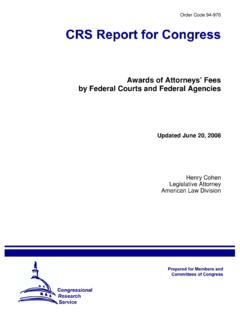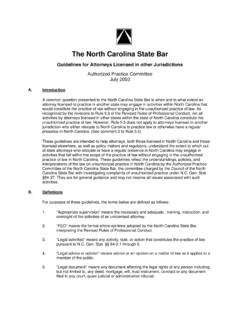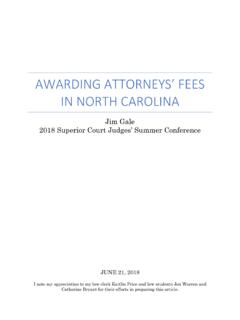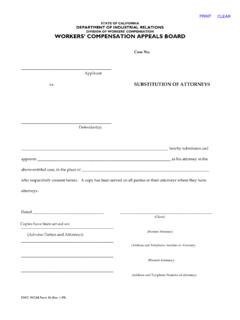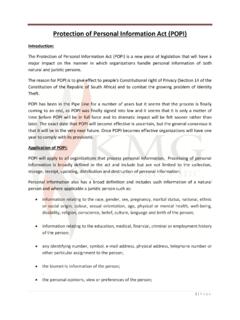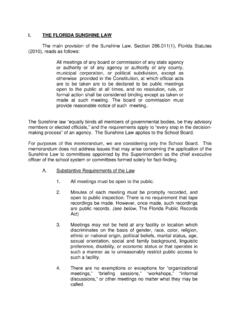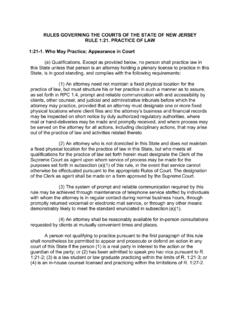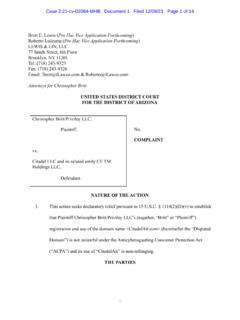Transcription of Attorneys Audit Technique Guide - IRS tax forms
1 Attorneys Audit Technique Guide NOTE: This document is not an official pronouncement of the law or the position of the Service and cannot be used, cited, or relied upon as such. This Guide is current through the publication date. Since changes may have occurred after the publication date that would affect the accuracy of this document, no guarantees are made concerning the technical accuracy after the publication date. Revision Date - March 2011 Page 1 of 52 Table of Contents Chapter 1 - Overview of attorney Returns .. 3 Introduction .. 3 RecordKeeping .. 4 Bank Accounts .. 5 General Trust Account .. 6 Segregated Trust Account .. 6 Other Revenue Sources .. 7 Client-Related Expenses .. 7 attorney -Client Privilege .. 8 General Rules .. 8 Fee Arrangements and Client Identity .. 9 Summonses .. 10 Information Reports .. 11 Summary .. 12 Exhibit 1-2 attorney -Client Privilege .. 13 Chapter 2 - Audit Steps .. 15 Pre-Contact Analysis .. 15 Accurint Searches.
2 15 Internet Searches .. 16 Web Currency and Banking Retrieval System (WEB CBRS).. 16 Return Preparer Listings .. 18 IRP Transcript .. 18 Comparative Analysis .. 18 Information Document Requests .. 18 Initial Interview .. 18 Exhibit 2-1, Sample Information Document Request (IDR) .. 21 Exhibit 2-2 Bank Document Request List .. 22 Exhibit 2-3 Interview .. 24 Chapter 3 - Audit Issues .. 28 Gross Income .. 28 Introduction .. 28 Gross Income Types .. 28 Client Trust Accounts .. 30 Noncash Sources .. 30 Cash Payments .. 31 Constructive Receipt .. 31 Expenses .. 32 Entertainment, Promotion and Advertising .. 32 Travel .. 33 Disguised Hobbies .. 33 Corporate Expenses .. 33 Depreciable Books and Periodicals .. 33 Advanced Client Costs .. 34 Page 2 of 52 Employee Versus Independent Contractor Issue .. 39 Corporate Officer is an Employee .. 43 1099 Issues: .. 43 form 8300 Issue .. 43 Related Entities/Taxpayers .. 44 Corporate Taxpayers .. 44 Corporate and Individuals.
3 44 Personal Service Corporation Accounting Periods and Tax Computations .. 45 Exhibit 3-1 Client Costs and Advances .. 48 Exhibit 3-2 .. 49 Exhibit 3-3 20 Common-Law Factors/Rev Rul 87-41 .. 51 Page 3 of 52 Chapter 1 - Overview of attorney Returns Introduction The right to practice law as an attorney is contingent on being admitted by a state and/or federal bar. These requirements differ from state to state. Typically, a law degree from an accredited law school is required to sit for the State Bar examination. On passing any required examinations and satisfying any other requirements, such as a background check or committee review on character and fitness, the applicant is licensed to practice law. Some courts have additional requirements an attorney must satisfy in order to appear before them. For example, practice before the Supreme Court requires an attorney to have been admitted to practice in the highest court of a State, Commonwealth, Territory or Possession, or the District of Columbia for a period of at least three years immediately before the date of application; must not have been the subject of any adverse disciplinary action pronounced or in effect during that 3-year period; and must appear to the Court to be of good moral and professional character.
4 The attorney also must have the personal recommendation of two Attorneys already admitted to practice before the Supreme Court. Each federal or circuit court establishes requirements to practice, as do special courts, such as the Tax Court and the Court of Claims. In the United States, Attorneys practice their craft in a variety of ways. Some work as employees for government agencies, or serve as in-house counsel for larger corporations. Also, a large number of Attorneys are self-employed, operating their own sole proprietorships, alone or in a shared expense relationship with other sole proprietors, or as partners or shareholders of larger law firms. This Guide will assist you in examining an attorney s tax returns. Examining an attorney s return is not unlike the examination of any other business. However, examiners may need to address different issues depending on an attorney s area(s) of expertise. For example, personal injury Attorneys typically work on a fee contingency basis.
5 This means that the attorney is paid a percentage of the amount recovered by their client. This percentage may vary depending on the outcome of the case. Typically, an attorney would earn a lower percentage for a case that is settled out of court rather than taken to trial. Examiners should also be aware that, depending on the attorney s specialty, clients might pay a large portion of their fees well in advance. This should be taken into consideration during the examiner s pre-planning activities. Another consideration is that some Attorneys may have a greater percentage of cash receipts than others. For example, criminal and immigration Attorneys are in a position to receive cash for services, as their clients may not utilize banks. Currency Transaction Reports (CTR's), posted to the IRP report may be helpful in determining if an attorney has received large cash payments. Details on each individual CTR are available on the Web CBRS system.
6 Page 4 of 52 Attorneys provide their services through sole proprietorships, partnerships, corporations, and limited liability companies. Each entity is subject to unique tax issues. These issues are common to many professional services in addition to Attorneys . If the attorney provides services through a corporation, you may face issues including, but not limited to; the corporation being classified as a personal service corporation under IRC 441; constructive dividends; loans to shareholders; or use of corporate assets. S-corporations also raise additional issues, such as inadequate compensation and built in gains. You need to consider whether the business structure used by the attorney raises any unique examination issues. Some of these issues are discussed in Chapter 3. The formula for auditing these returns is simply good use of regular Audit techniques: a thorough pre-contact analysis, a fully prepared initial interview, an in-depth inspection of the taxpayer's income records, and judicious use of third-party contacts to verify or refute the taxpayer's assertions.
7 RecordKeeping A good accounting system for Attorneys will include strong internal controls to monitor both fees billed and costs and expenses advanced for clients. There are four major types of fee arrangements that Attorneys use. These are discussed below in the income section. All four types of fee arrangements are based upon the amount of time an attorney spends on a particular matter. For that reason, Attorneys typically maintain detailed records to track the exact time spent on any given case. Before time and billing software was used, this information was recorded on client ledger cards. These cards included the time spent on the client s matter, along with all chargeable expenses. Now, this procedure is often accomplished through the use of automated software. These software programs often utilize pop-up timers on office workstations, where the firm s attorney or administrative employee will enter the client s code and click on a start button to commence billing the client for the time involved on a particular task.
8 Advanced costs are recorded into the system in a similar fashion to other accounts receivables. Usually at the end of each month, the partner assigned to a particular case will review hours and other costs charged to the client and make adjustments to the client s bill, if warranted, prior to issuance. This adjustment log should be reviewed as part of the examination, along with reconciliation of the output of the time and billing system to the appropriate accounts in the general ledger. Attorneys may also maintain time charged and expense information in the client s file. Generally, the cash receipts journal will show a breakdown between fees received and expense reimbursements. The cash disbursements journal should show an allocation between regular overhead expenses paid and client costs paid. The records for smaller firms and sole practitioners may consist of the bank statements and checks. Regardless of the business size, there should still be client ledgers and files.
9 Attorneys usually maintain the following records: Page 5 of 52 1. Appointment book; 2. Client card index; 3. Receipts Journal or Daily log; 4. Disbursements journal, book or other record reflecting the breakdown of regular expenses paid from bank accounts as well as disbursements made from client trust funds. These disbursement records should provide a mechanism from which disbursements chargeable to a specific client can be noted on their records for billing purposes. The attorney may also maintain a petty cash journal; 5. Accounts Receivable journal showing billed receivables; 6. Individual client accounts including a description of services rendered, charges and credits, a summary of unbilled charges and work in progress, and final invoices; 7. Case time records per client; 8. Register of cases in progress, oftentimes organized by client's name; and 9. Time summary reports, sorted by attorney and by client, listing the time, dates of work, billings and/or charges.
10 Examiners can test the validity of reported income by comparing and reconciling the data provided on the above listed reports. Bank Accounts Most legal practices use a general operating account and one or more trust accounts. In addition, there may be separate accounts used for payroll, savings, or investment activity. Only the trust accounts have features which are unique to Attorneys and will be discussed in detail. An explanation will be given of how these accounts should be handled. Trust accounts should be used for all funds and assets received or held by an attorney for the benefit of their clients. The attorney is the trustee of the account and has the power to disburse funds on the client's behalf. Trust funds are oftentimes required to be placed in interest bearing accounts, and typically checking accounts are used. These accounts are under the control of the attorney and are labeled "Trust Account," " attorney /Client Trust Account," "Client's Funds Account," or some similar title.










